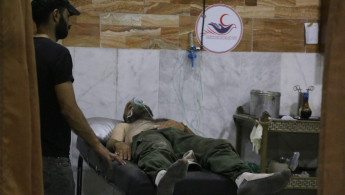Evidence 'definitely proves' Syrian regime behind largest chemical attack
Samples taken by a UN mission after a chemical attack on August 21, 2013 which left hundreds dead from sarin gas poisoning were compared with chemicals handed over by Damascus for destruction in 2014.
Laboratories for the Organisation for the Prohibition of Chemical Weapons found "markers" in samples taken at Ghouta and Khan Sheikhoun in Idlib, another site of two other nerve agent attacks on April 4, 2017, reported Reuters on Tuesday.
"We compared Khan Sheikhoun, Khan al-Assal, Ghouta," said one source to Reuters who asked not to be named because of the sensitivity of the findings. "There were signatures in all three of them that matched."
The test results formed the basis of a report by the OPCW-UN Joint Investigative Mechanism in October which linked the Syrian regime to the attack in Khan Sheikhoun that left dozens dead.
The report to the UN Security Council did not include the findings on Ghouta as it was not part of the team's remit.
The findings however buttress claims previously echoed by the United States, Britain and other Western powers that the Assad regime is in possession and uses banned weaponries, violating several Security Council resolutions and the Chemical Weapons Convention.
"A match of samples from the 2013 Ghouta attacks to tests of chemicals in the Syrian stockpile is the equivalent of DNA evidence: definitive proof," said Amy Smithson, a US nonproliferation expert.
The hexamine finding "is a particularly significant match," Smithson said, because it is a chemical identified as a unique hallmark of the Syrian military's process to make sarin.
"This match adds to the mountain of physical evidence that points conclusively, without a shadow of doubt, to the Syrian government," she said.
Damascus has denied using any chemical weapons in the seven-year conflict, blaming the rebels on using it on themselves. Long-time ally Russia has also denied the use of chemical weapons by the Syrian regime and called into question the results of the OCPW inquiries with officials in Moscow claiming that the rebels staged the attacks to discredit the Syrian government and whip up international condemnation.
Article continues below
Damascus joined the OPCW and agreed to destroy its 1,300-tonne stockpile of industrial munition following a US-Russian deal after the Ghouta attack in 2013, a stockpile now linked to the attack.
Despite agreeing to destroy the industrial precursors, inspectors have found evidence of an ongoing chemical weapons programme in the country, including systematic use of chlorine barrel bombs and sarin.
Last week, twenty-four countries pushed for sanctions against perpetrators of chemical attacks in Syria following a chemical attack that hospitalised 21 people in rebel-held Eastern Ghouta.
US Secretary of State Rex Tillerson said Russia "ultimately bears responsibility" for such strikes, ratcheting up the pressure against Syrian regime backer Moscow.
"Whoever conducted the attacks, Russia ultimately bears responsibility for the victims in East Ghouta and countless other Syrians targeted with chemical weapons since Russia became involved in Syria," Tillerson.
"There is simply no denying that Russia, by shielding its Syrian ally, has breached its commitments to the US as a framework guarantor" overseeing the destruction of Syria's chemical weapons stockpiles, as agreed in September 2013, he added.
Russia responded with an angry rebuke and called for an investigation, which the 24 countries said was an attempt to derail their efforts to punish the perpetrators.
The Eastern Ghouta left its victims - including children - struggling to breathe and follows a similar attack around two weeks earlier, leading to calls by UN chief for Syria to be taken to the International Criminal Court.
Around 500,000 people have died and millions made homeless in seven years of fighting in Syria, which was sparked when regime forces brutally put down peaceful protests in 2011.





 Follow the Middle East's top stories in English at The New Arab on Google News
Follow the Middle East's top stories in English at The New Arab on Google News
![The UAE is widely suspected of arming the RSF militia [Getty]](/sites/default/files/styles/image_330x185/public/2024-11/GettyImages-472529908.jpg?h=69f2b9d0&itok=Yauw3YTG)
![Netanyahu furiously denounced the ICC [Getty]](/sites/default/files/styles/image_330x185/public/2024-11/GettyImages-2169352575.jpg?h=199d8c1f&itok=-vRiruf5)
![Both Hamas and the Palestinian Authority welcomed the ICC arrest warrants [Getty]](/sites/default/files/styles/image_330x185/public/2024-11/GettyImages-2178351173.jpg?h=199d8c1f&itok=TV858iVg)